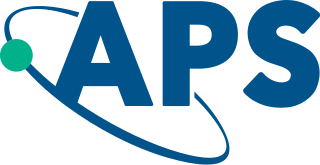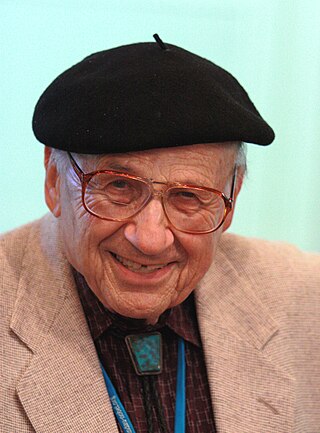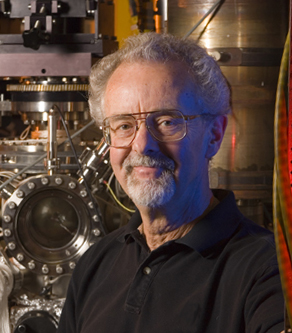
The American Physical Society (APS) is a not-for-profit membership organization of professionals in physics and related disciplines, comprising nearly fifty divisions, sections, and other units. Its mission is the advancement and diffusion of knowledge of physics. It publishes more than a dozen scientific journals, including the prestigious Physical Review and Physical Review Letters, and organizes more than twenty science meetings each year. It is a member society of the American Institute of Physics. Since January 2021, it is led by chief executive officer Jonathan Bagger.

David Jonathan Gross is an American theoretical physicist and string theorist. Along with Frank Wilczek and David Politzer, he was awarded the 2004 Nobel Prize in Physics for their discovery of asymptotic freedom. Gross is the Chancellor's Chair Professor of Theoretical Physics at the Kavli Institute for Theoretical Physics (KITP) of the University of California, Santa Barbara (UCSB), and was formerly the KITP director and holder of their Frederick W. Gluck Chair in Theoretical Physics. He is also a faculty member in the UCSB Physics Department and is affiliated with the Institute for Quantum Studies at Chapman University in California. He is a foreign member of the Chinese Academy of Sciences.

Walter Kohn was an Austrian-American theoretical physicist and theoretical chemist. He was awarded, with John Pople, the Nobel Prize in Chemistry in 1998. The award recognized their contributions to the understandings of the electronic properties of materials. In particular, Kohn played the leading role in the development of density functional theory, which made it possible to calculate quantum mechanical electronic structure by equations involving the electronic density. This computational simplification led to more accurate calculations on complex systems as well as many new insights, and it has become an essential tool for materials science, condensed-phase physics, and the chemical physics of atoms and molecules.

Juan Ignacio Cirac Sasturain, known professionally as Ignacio Cirac, is a Spanish physicist. He is one of the pioneers of the field of quantum computing and quantum information theory. He is the recipient of the 2006 Prince of Asturias Award in technical and scientific research.

Earl Ward Plummer was an American physicist. His main contributions were in surface physics of metals. Plummer was a professor of physics at Louisiana State University, University of Pennsylvania and the University of Tennessee - Knoxville.

Galen D. Stucky is an American inorganic materials chemist who is a Distinguished Professor and the Essam Khashoggi Chair In Materials Chemistry at the University of California, Santa Barbara. He is noted for his work with porous ordered mesoporous materials such as SBA-15. He won the Prince of Asturias Award in 2014, in the Scientific and Technological Research area. Stucky was elected a member of the American Association for the Advancement of Science in 1994, a member of the American Academy of Arts and Sciences in 2005, and a member of the National Academy of Sciences in 2013.
The Medard W. Welch Award is given to scientists who demonstrated outstanding research in the fields pertinent to the focus areas of the American Vacuum Society, which are "the basic science, technology development, and commercialization of materials, interfaces, and processing." It was established in 1969 in memory of Medard W. Welch, a founder of the American Vacuum Society.
Dr. Rudolf Maria "Ruud" Tromp is a Dutch American scientist at IBM Research Division, Thomas J. Watson Research Center and a Physics Professor at Leiden University.
David Erik Aspnes is an American physicist and a member of the National Academy of Sciences (1998). Aspnes developed fundamental theories of the linear and nonlinear optical properties of materials and thin films, and the technology of spectroscopic ellipsometry (SE). SE is a metrology that is used in the manufacture of integrated circuits.
The David Adler Lectureship Award in the Field of Materials Physics is a prize that has been awarded annually by the American Physical Society since 1988. The recipient is chosen for "an outstanding contributor to the field of materials physics, who is noted for the quality of his/her research, review articles and lecturing." The prize is named after physicist David Adler with contributions to the endowment by friends of David Adler and major support from Energy Conversion Devices, Inc., as well as support from the American Physical Society's Division of Materials Physics. The prize includes a $5,000 honorarium.

Myriam Paula Sarachik was a Belgian-born American experimental physicist who specialized in low-temperature solid state physics. From 1996, she was a distinguished professor of physics at the City College of New York. She is known for the first experimental confirmation of the Kondo effect in the 1960s.

Ching Wan Tang is a Hong Kong–American physical chemist. He was inducted into the National Inventors Hall of Fame in 2018 for inventing OLED, and was awarded the 2011 Wolf Prize in Chemistry. Tang is the IAS Bank of East Asia Professor at the Hong Kong University of Science and Technology and previously served as the Doris Johns Cherry Professor at the University of Rochester.

Harold ("Hal") Warren Lewis was an American Emeritus Professor of Physics and former department chairman at the University of California, Santa Barbara (UCSB). He was chairman of the JASON Defense Advisory Group from 1966 to 1973, and was active in US government investigations into safety of nuclear reactors.
Homer Dupre Hagstrum was an American physicist who specialized in surface physics.

Mark J. Cardillo is an American chemist currently at The Camille and Henry Dreyfus Foundation and an Elected Fellow of the American Association for the Advancement of Science.
William Edward Spicer was an American engineering academic.

Pablo Jarillo-Herrero is a Spanish physicist and current Cecil and Ida Green Professor of Physics at Massachusetts Institute of Technology (MIT).

Theodore E. Madey was an American condensed matter physicist who specialized in the chemistry and physics of surfaces. He was a professor in the physics and chemistry departments at Rutgers University at the time of his death.

Matthias Scheffler is a German theoretical physicist whose research focuses on condensed matter theory, materials science, and artificial intelligence. He is particularly known for his contributions to density-functional theory and many-electron quantum mechanics and for his development of multiscale approaches. In the latter, he combines electronic-structure theory with thermodynamics and statistical mechanics, and also employs numerical methods from engineering. As summarized by his appeal "Get Real!" he introduced environmental factors into ab initio calculations. In recent years, he has increasingly focused on data-centric scientific concepts and methods and on the goal that materials-science data must become "Findable and Artificial Intelligence Ready".













